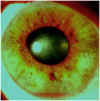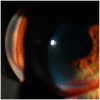NEOVASCULAR SECONDARY GLAUCOMA, ETIOLOGY AND PATHOGENESIS
- PMID: 27373111
- PMCID: PMC5729807
NEOVASCULAR SECONDARY GLAUCOMA, ETIOLOGY AND PATHOGENESIS
Abstract
Rationale: Neovascular secondary glaucoma is a condition characterized by increased intraocular pressure due to the neovascularization occurring at the iridocorneal angle and iris, the most common complication of end-stage ischemic retina. The early diagnosis and treatment of this disease are important, because the functional prognosis is reserved.
Objective: Knowing and understanding the etiology and pathogenesis of neovascular secondary glaucoma.
Methods and results: Review of the angiogenesis theory to understand the etiology and pathogenesis of neovascular secondary glaucoma. VEGF is the most studied proangiogenic factor involved in the neovascular glaucoma pathogenesis. The 9 isoforms contain consensus signal sequences for extracellular secretion, all of them binding to a specific receptor subtype and stimulating tissue specific angiogenesis. VEGF and VEGF-m RNA levels are significantly increased in the ischemic retina. Diabetes mellitus (with diabetic retinopathy), central retinal vein thrombosis and repeated retinal detachments are diseases that cause neovascular glaucoma through ischemia.
Discussion: Correct evaluation of the iris neovascularization followed by a proper treatment is the most important in a case of secondary neovascular glaucoma. Repeated gonioscopy is indicated in cases with high risk of developing neovascular glaucoma. Close monitoring of a patient with high thromboembolic risk: valvular heart disease, open-heart surgery, other angioplasties.
Figures
References
-
- Haefliger IO, Zschaner A, Anderson DR. Relaxation of retinal pericyte contractile tone through the nitric oxide cyclic guanosin monophosphat pathway. Invest.Opth.Vis.Sci. . 1994 - PubMed
-
- Ferrara N. Vascular endothelial growth factor: basic science and clinical progress. Endocr Rev. 2004;25:581–611. - PubMed
-
- Evans K, Wishart PK, Galliard JN. Neovascular complication after central vein occlusion. The Eye. 1993;7 - PubMed
-
- Leonard AL, Daniel MA. Mechanisms and Management. Elsevier; 2010. Ocular Diseases.
-
- Bandello F, Battaglia Parodi M. Anti-VEGF Developments in Ophthalmoly. 2010
Publication types
MeSH terms
Substances
LinkOut - more resources
Full Text Sources




